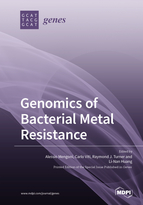Genomics of Bacterial Metal Resistance
A special issue of Genes (ISSN 2073-4425). This special issue belongs to the section "Microbial Genetics and Genomics".
Deadline for manuscript submissions: closed (30 September 2018) | Viewed by 67208
Special Issue Editors
Interests: rhizospheric and endophytic microbiomes; microbial evolution; bacterial genetics and ecology
Special Issues, Collections and Topics in MDPI journals
Interests: microbial ecology; metagenomics; phenomics
Special Issues, Collections and Topics in MDPI journals
Interests: metal based antimicrobials; resistance mechanisms; biofilms; antimicrobial properties; bioremediation; metal nanomaterials
Special Issues, Collections and Topics in MDPI journals
Special Issue Information
Dear Colleagues,
Bacteria develop metal resistance in a variety of environments, both natural and anthropogenic. Metal resistant bacteria are routinely isolated from natural metal ion rich environments as well as metal polluted sites from mining/refining/manufacturing operations. Additionally, we now recognize an increased metal load from our dense city populations leading to high metal accumulation in water treatment plants. Further there is now an increased use of metal-based antimicrobials to help with solutions to the antimicrobial resistance era threats. All these metal load situations lead to bacteria evolving metal resistance. Metal ion resistance may be through specific gene(s) or operon(s) evolved for resistance towards a specific metal. Or the resistance may be due to a combination of genes expressed uniquely that leads to a physiology of either specific or multimetal resistance. Additionally, evolving metal resistance may also lead to develop antibiotic resistance. Finally, bacterial communities of heavy-metal contaminated sites are also important examples of evolution and adaptation of biotic communities and a source of biotechnologically relevant strains.
Here, we are recognizing the important field of bacterial metal resistance through a targeted Special Issue on genomics.
We kindly invite researchers working on any of these areas to submit their original research or review articles to this Special Issue.
Prof. Alessio MengoniProf. Carlo Viti
Prof. Raymond J. Turner
Prof. Li-Nan Huang
Guest Editors
Manuscript Submission Information
Manuscripts should be submitted online at www.mdpi.com by registering and logging in to this website. Once you are registered, click here to go to the submission form. Manuscripts can be submitted until the deadline. All submissions that pass pre-check are peer-reviewed. Accepted papers will be published continuously in the journal (as soon as accepted) and will be listed together on the special issue website. Research articles, review articles as well as short communications are invited. For planned papers, a title and short abstract (about 100 words) can be sent to the Editorial Office for announcement on this website.
Submitted manuscripts should not have been published previously, nor be under consideration for publication elsewhere (except conference proceedings papers). All manuscripts are thoroughly refereed through a single-blind peer-review process. A guide for authors and other relevant information for submission of manuscripts is available on the Instructions for Authors page. Genes is an international peer-reviewed open access monthly journal published by MDPI.
Please visit the Instructions for Authors page before submitting a manuscript. The Article Processing Charge (APC) for publication in this open access journal is 2600 CHF (Swiss Francs). Submitted papers should be well formatted and use good English. Authors may use MDPI's English editing service prior to publication or during author revisions.
Keywords
- pangenome
- genomic islands
- heavy metals
- metalloids
- metal resistance genes
- metal stress genes
- metal response
- metal gene prevalence
- biofilm
- metagenomics
- microbiome
- serpentine
- mining
- bioremediation










